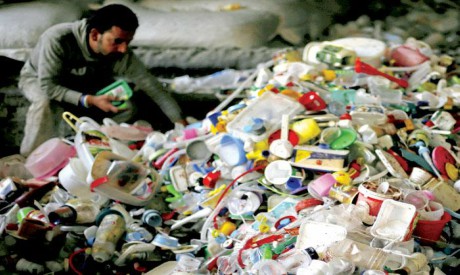
A worker picks through rubbish in garbage dump at a small recycling factory near Zaraeeb in the shanty area known also as Zabaleen or “Garbage City” on the Mokattam Hills in eastern Cairo, Egypt (Photo: Reuters)
Best practices in the management and recycling of waste and its conversion into energy were the themes of a discussion hosted by the Swedish Embassy in Cairo last week entitled “Green Talks: Sustainable Approaches to Waste Management”.
The event was held in cooperation with the Egyptian National Clean Production Centre and saw participation from both Swedish and Egyptian experts in the field.
“We are happy to be able to create a platform to further the dialogue around such an important issue that favours sustainable environmental and economic development. Egypt and Sweden are both fully committed to meet the UN Sustainable Development Goals” in this and other fields, Medhat Fayek, deputy CEO of ABB Egypt, said at the seminar.
ABB had some 50 years of experience in waste management, Fayek said, and it was now working to create advanced solutions to manage waste-to-energy plants while preserving natural resources and the environment.
“Waste-to-energy is a tremendous way not only to reduce waste, but also to recover valuable resources and serve as a vital part of the sustainable waste-management chain to become a legitimate addition to the recycling process,” Fayek said.
Plants of this type transform waste into electrical or thermal energy to be used in industrial processing or central heating systems. These are environmentally safe and cost-effective energy recovery solutions.
A typical plant size is 60 MW, and the waste is typically also reduced by about 80 per cent in volume.
Participants at the seminar also explored solutions that help to reduce waste storage, allowing a more consistent waste-recycling process and exploitation to the fullest.
This enables municipalities, waste-management companies, utilities, and financial institutions to generate more energy.
The example of the SYSAV Mualmö plant in Sweden was presented, in which a new incineration line was commissioned in 2004 with a capacity of 25 tons of waste per hour, a heat production of 63 MW, and an electricity production of 26 MW.
Another example was the Infraserv Hoechst plant in Germany, which has three environmentally friendly incinerators for the combustion of refuse-derived fuel (RDF) that produce energy for a nearby industrial park.
Ahmed Gaber, professor of Chemical Engineering at Cairo University and chair of the Chemonics Egypt consultancy, said proper waste management could secure Egyptian young people more than two million green jobs.
“We can benefit from the Swedish experience as they are in the forefront in utilising waste and even import waste to satisfy their energy needs. Cairo produces more than 1,000 tons of waste per day, and if this is used to generate energy it will also generate money, green jobs and other benefits,” Gaber said.
A local example of using waste was given by Hamed Al-Mousli, a professor of engineering at Ain Shams University in Cairo, who pointed to a project to use palm by-products.
Egypt has almost 15 million palm trees, and plants could be built to burn their by-products to produce energy, Al-Mousli said, including dried leaves, spathes and sheaths.
Other uses for palm by-products include the production of furniture out of palm midribs, and treated palm waste can also be used as animal feed as well as in the production of organic composites.
Agricultural waste such as sugarcane leaves is also being used for straw and cattle feed in Upper Egypt, participants at the seminar said.
*A version of this article appears in print in the 15 November, 2018 edition of Al-Ahram Weekly under the headline: Waste into energy
Short link: